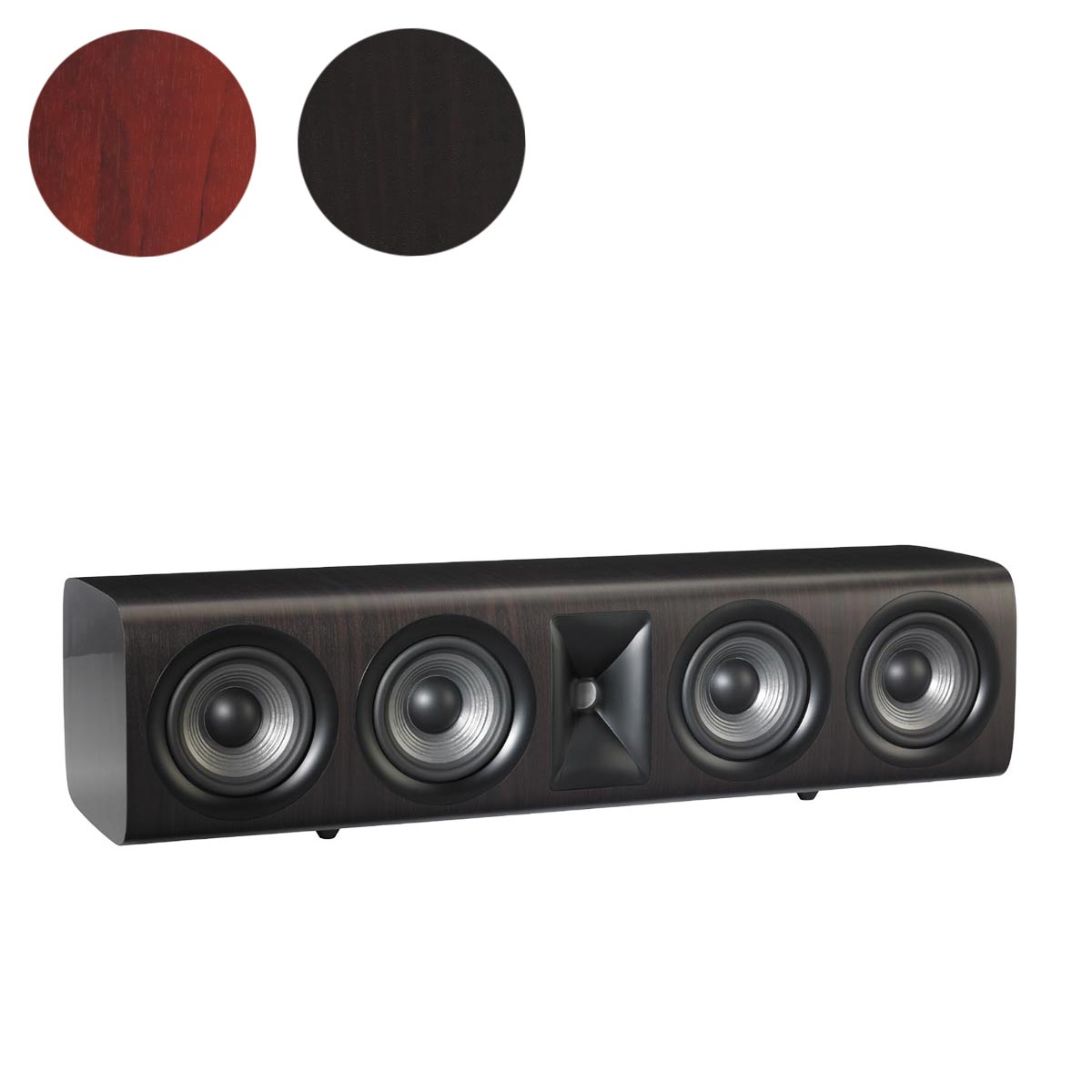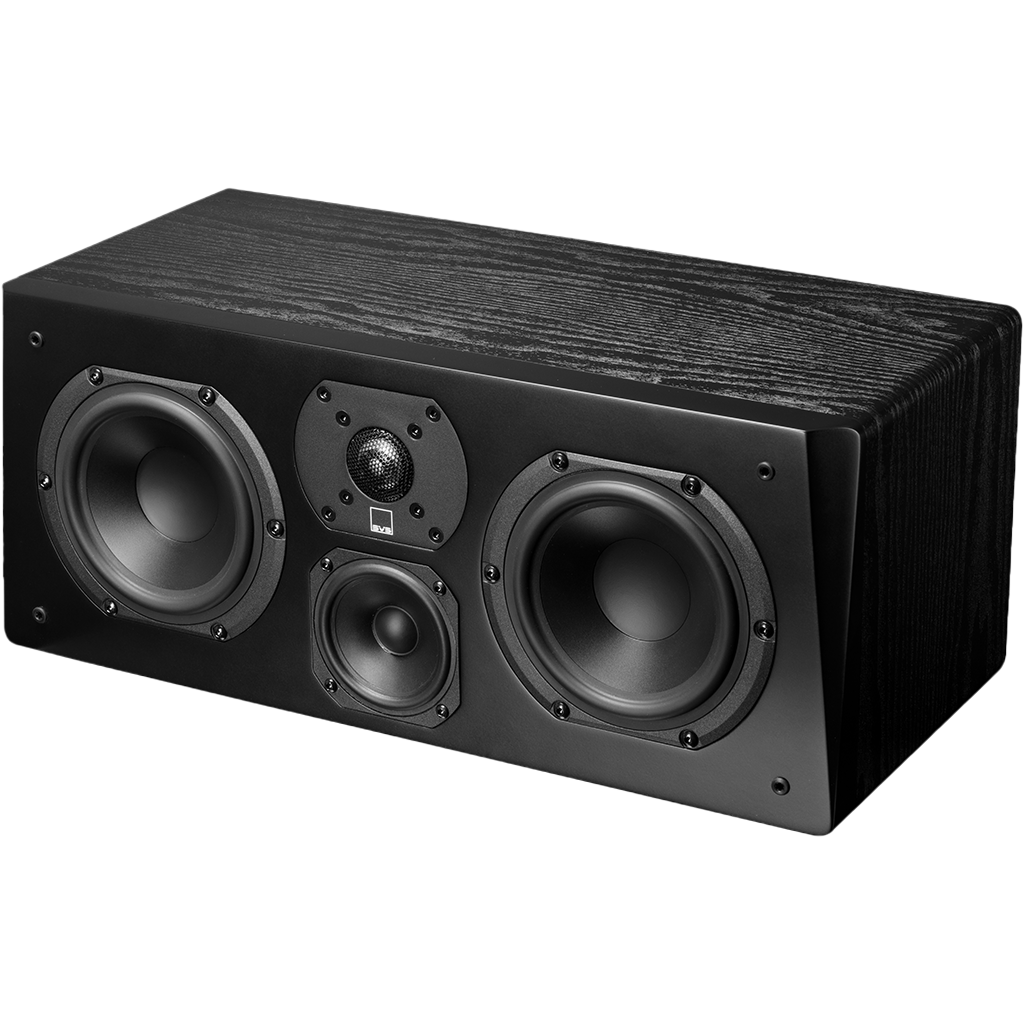This is a review and detailed measurements of the JBL 135C center home theater speaker. It was kindly purchased new and drop shipped to me for testing. It is on sale now for US $170.
I really like the look of 135C:

This is a 2-way design and other brands we have tested of this kind have proved disappointing for center speaker usage. Will this be different? We will find out.
NOTE: our company, Madrona Digital is a dealer for Harman which includes JBL line. So feel free to read whatever level of bias you like in my subjective remarks.
Measurements that you are about to see were performed using the Klippel Near-field Scanner (NFS). This is a robotic measurement system that analyzes the speaker all around and is able (using advanced mathematics and dual scan) to subtract room reflections (so where I measure it doesn't matter). It also measures the speaker at close distance ("near-field") which sharply reduces the impact of room noise. Both of these factors enable testing in ordinary rooms yet results that can be more accurate than an anechoic chamber. In a nutshell, the measurements show the actual sound coming out of the speaker independent of the room.
Measurements are compliant with latest speaker research into what can predict the speaker preference and is standardized in CEA/CTA-2034 ANSI specifications. Likewise listening tests are performed per research that shows mono listening is much more revealing of differences between speakers than stereo or multichannel.
Reference axis was the center of the tweeter (aligned by eye). It is getting colder with the measurement room temp at 15 degrees C. Much more samples were taken for measurement of the 135C due to complex sound field created by the interference between all the drivers. Accuracy is better than 1% for most of the range but drops to 2% for part of the spectrum.
JBL 135C Measurements
Acoustic measurements can be grouped in a way that can be perceptually analyzed to determine how good a speaker is and how it can be used in a room. This so called spinorama shows us just about everything we need to know about the speaker with respect to tonality and some flaws:

I must say, I was not ready for how ugly this looks. We have a bunch of flaws mixed in from lack of deep bass to resonances and directivity error. The only good news is high sensitivity to the tune of near 90 dB.
Due to directivity error which we will cover later, off-axis response is just as chewed up:

Somehow it becomes smoother when combined to predict the overall room response:

The increase in energy at 200 Hz gives the sensation of bass to the unitiated but I find such sound tubby and undesirable. We also have some increase in high frequencies combining to present somewhat of a "showroom sound" for a small speaker.
Near-field measurements show some pronounced resonances:

The ports by the way are at each end of the speaker.
Now we get to the disappointing part: horizontal directivity and beam width:


A center speaker needs to cover wide audience range and this is the opposite. The driver array has destructive cancellation that causes it to highly "beam" (narrow) in response from 300 Hz up to near 3 kHz. A lot of the vocal range falls in this area so voices are definitely going to be impacted.
While we don't need good vertical directivity, we have it here:

One nice thing I have found with multiple drivers is that they handle power very well. Even though these drivers are small they still do an excellent job here:


Impedance is typical of speakers these days, dropping down to 4 ohms:

For fans of timing analysis, here are the waterfall and impulse responses:


JBL 135C Listening Tests and Equalization
I always listen on-axis to speakers which helped the 135C hide its horizontal directivity. Here, I found the sound as predicted, tubby depending on the track and a bit bright. Moving just half a seat horizontally, killed the clarity and openness of vocals. Figuring some don't need multi-seat coverage, I attempted to fix the high level flaws using equalization:

I put in the filter at 200 Hz to get rid of overboosted response there. That got rid of the tubbiness but then highlighted the highs even more. So I dialed in the shelving filter on the right and got that fixed. Problem was, I now lost most of the bass response. I dialed in a quick and dirty low shelf and was surprised how well that worked. I had warmth and good bass now with no noticeable rise in distortion! Once there, as long as you sat on-axis, the sound was quite enjoyable with good ability to play loud.
Conclusions
JBL nails the price and looks of this speaker together with svelte form factor. Alas, it attempts to fight physics and loses on horizontal directivity. No doubt marketing and cost dictated this configuration as their competitors are guilty of the same. Fortunately it responded well to manual equalization (automatic may not work well). So if you want to listen alone, you should be fine. Note that you can't use it vertically due to the ports at each end unless you hang it on the wall.
I can't recommend the JBL 135C as a center speaker.
----------
As always, questions, comments, recommendations, etc. are welcome.
Any donations are much appreciated using: https://www.audiosciencereview.com/forum/index.php?threads/how-to-support-audio-science-review.8150/
I really like the look of 135C:
This is a 2-way design and other brands we have tested of this kind have proved disappointing for center speaker usage. Will this be different? We will find out.
NOTE: our company, Madrona Digital is a dealer for Harman which includes JBL line. So feel free to read whatever level of bias you like in my subjective remarks.
Measurements that you are about to see were performed using the Klippel Near-field Scanner (NFS). This is a robotic measurement system that analyzes the speaker all around and is able (using advanced mathematics and dual scan) to subtract room reflections (so where I measure it doesn't matter). It also measures the speaker at close distance ("near-field") which sharply reduces the impact of room noise. Both of these factors enable testing in ordinary rooms yet results that can be more accurate than an anechoic chamber. In a nutshell, the measurements show the actual sound coming out of the speaker independent of the room.
Measurements are compliant with latest speaker research into what can predict the speaker preference and is standardized in CEA/CTA-2034 ANSI specifications. Likewise listening tests are performed per research that shows mono listening is much more revealing of differences between speakers than stereo or multichannel.
Reference axis was the center of the tweeter (aligned by eye). It is getting colder with the measurement room temp at 15 degrees C. Much more samples were taken for measurement of the 135C due to complex sound field created by the interference between all the drivers. Accuracy is better than 1% for most of the range but drops to 2% for part of the spectrum.
JBL 135C Measurements
Acoustic measurements can be grouped in a way that can be perceptually analyzed to determine how good a speaker is and how it can be used in a room. This so called spinorama shows us just about everything we need to know about the speaker with respect to tonality and some flaws:
I must say, I was not ready for how ugly this looks. We have a bunch of flaws mixed in from lack of deep bass to resonances and directivity error. The only good news is high sensitivity to the tune of near 90 dB.
Due to directivity error which we will cover later, off-axis response is just as chewed up:
Somehow it becomes smoother when combined to predict the overall room response:
The increase in energy at 200 Hz gives the sensation of bass to the unitiated but I find such sound tubby and undesirable. We also have some increase in high frequencies combining to present somewhat of a "showroom sound" for a small speaker.
Near-field measurements show some pronounced resonances:
The ports by the way are at each end of the speaker.
Now we get to the disappointing part: horizontal directivity and beam width:
A center speaker needs to cover wide audience range and this is the opposite. The driver array has destructive cancellation that causes it to highly "beam" (narrow) in response from 300 Hz up to near 3 kHz. A lot of the vocal range falls in this area so voices are definitely going to be impacted.
While we don't need good vertical directivity, we have it here:
One nice thing I have found with multiple drivers is that they handle power very well. Even though these drivers are small they still do an excellent job here:
Impedance is typical of speakers these days, dropping down to 4 ohms:
For fans of timing analysis, here are the waterfall and impulse responses:
JBL 135C Listening Tests and Equalization
I always listen on-axis to speakers which helped the 135C hide its horizontal directivity. Here, I found the sound as predicted, tubby depending on the track and a bit bright. Moving just half a seat horizontally, killed the clarity and openness of vocals. Figuring some don't need multi-seat coverage, I attempted to fix the high level flaws using equalization:
I put in the filter at 200 Hz to get rid of overboosted response there. That got rid of the tubbiness but then highlighted the highs even more. So I dialed in the shelving filter on the right and got that fixed. Problem was, I now lost most of the bass response. I dialed in a quick and dirty low shelf and was surprised how well that worked. I had warmth and good bass now with no noticeable rise in distortion! Once there, as long as you sat on-axis, the sound was quite enjoyable with good ability to play loud.
Conclusions
JBL nails the price and looks of this speaker together with svelte form factor. Alas, it attempts to fight physics and loses on horizontal directivity. No doubt marketing and cost dictated this configuration as their competitors are guilty of the same. Fortunately it responded well to manual equalization (automatic may not work well). So if you want to listen alone, you should be fine. Note that you can't use it vertically due to the ports at each end unless you hang it on the wall.
I can't recommend the JBL 135C as a center speaker.
----------
As always, questions, comments, recommendations, etc. are welcome.
Any donations are much appreciated using: https://www.audiosciencereview.com/forum/index.php?threads/how-to-support-audio-science-review.8150/








